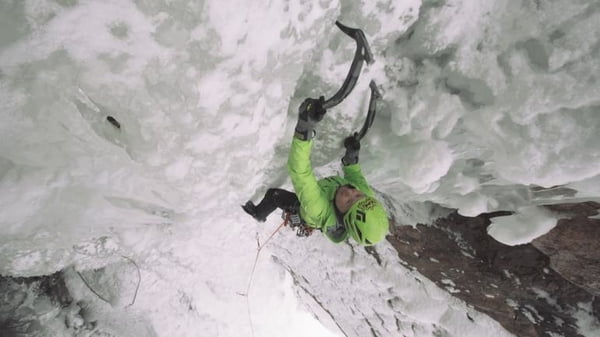
Daily Mountain
48 years, Australia
Ice climbing helped her out of addiction; now, she’s pulling others up
After strapping on all the required safety gear like helmets and crampons for our boots, Margo Talbot gives one last piece of advice before she starts climbing a wall of ice.
“If any ice starts coming down, move.”
Talbot is an ice climbing veteran, but safety is still at the front of her mind.
“I don’t call ice climbing a sport. I call it an endeavor, a practice. It’s got too much danger to call it a sport. But that’s one of the reasons I love it. The danger brings you completely into the present moment.”

Today, Talbot is climbing at the Ouray Ice Park in Ouray, Colorado. It’s a small mountain town nestled in the San Juan Mountains that’s affectionately known as the “Switzerland of America.”
A light flurry of snow is falling steadily as Talbot finishes prepping her gear. She’s completely unfazed by the snowfall, which seems to only enhance what she describes as an endeavor surrounded by natural beauty.
Standing at the bottom of this canyon, however, is much different than what Talbot considers her real “rock bottom”: sitting in a jail cell.
Demons and drugs
Talbot grew up in rural Canada and came across drugs and alcohol at any early age. She recalls smoking marijuana at 12 years old, gradually moving on to harder and harder drugs as the years went on.
By the time she was in her early 20s, she was freebasing cocaine. Looking back, Talbot says that she was using drugs to “self-medicate pain from childhood trauma.” She recalls a lot of emotional neglect as a child and found herself suicidally depressed by the time she was a young adult.
It wasn’t until she was arrested on drug charges, however, that she had an awakening. Sitting in her cell, struggling to catch a glimpse of the moon out of her tiny window, Talbot’s mind kept going back to an ice climbing outing she had gone on with her then-boyfriend.
“The very first time I went ice climbing, I felt joy for the first time in my life without the use of a heavy dose of street drugs.”
Sitting in her cell, she realized that her “relationship with nature was stronger than my relationship with drugs.”
“If you had asked me what I would miss about being in jail, I would have said the parties, the drugs, the highs. But what I missed was the wind in my hair and sun on my face.”
While locked in the cell, Talbot decided to trade in her drug addiction for a life of ice climbing.
Fighting addiction with an ice ax
Focusing on the glittering beauty and repetitive sounds, Talbot thinks of her time ice climbing as a “moving mediation.” The pounding of her crampons into the ice, the scraping of the ax to remove loose snow and the blunt whacking as the ax plunges into the ice: It’s the soundtrack of escape and a chance to “climb away from reality.” And for Talbot, she found wielding her ax was a helpful outlet for emotional release.
“People find ice climbing very empowering, especially women.”
Talbot teaches climbing clinics to show others the techniques she’s perfected on expeditions in the Canadian Rockies, the South Pole and many places in between. But perhaps more important to her is working as a mental health coach. Talbot says her own life experiences help others who have hit “their own rock bottom” relate to her.
“I can share the tools and techniques that helped me get through, and I can be the assurance that it is possible. I’m on the other side. If I can do it, you can do it.
She also spends time working with at-risk youth in Canada. Talbot helps with a wilderness adventure rehab program where she says the kids are “younger versions of myself” — ones who have had troubles with drugs or alcohol.
“One of the things I do is take them out ice climbing and then tell them my life story that night. It brings me joy to introduce others to the activity that literally changed my life.”
POSTED 3:11 PM, FEBRUARY 23, 2019, BY CNN WIRE





